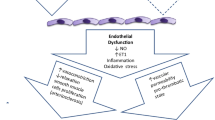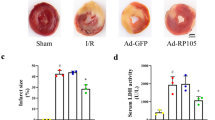ABSTRACT
We hypothesized that SIRS/endotoxemia-associated hyporesponsiveness to vasoconstrictors is mediated by smaller increases in intracellular Ca2+ levels due to reduced signaling via the STIM/Orai. Male Wistar rats were injected either with saline or bacterial LPS (i.p.; 10 mg/kg), and experiments were performed 24 h later. LPS-injected rats exhibited decreased systolic blood pressure, increased heart rate, neutrophils’ migration into the peritoneal cavity, and elevated alanine aminotransferase levels. Additionally, second-order mesenteric arteries from endotoxemic rats displayed hyporeactivity to contractile agents such as phenylephrine and potassium chloride; decreased contractile responses to Ca2+; reduced contraction during Ca2+ loading; and smaller intracellular Ca2+ stores. Decreased Orai1, but not STIM1, expression was found in resistance mesenteric arteries from LPS-treated rats. Additionally, cultured vascular smooth muscle cell (VSMC) treated with LPS resulted in increased TLR-4 expression, but Myd-88 and STIM-1 expression were not changed. Our data suggest that in endotoxemia, Ca2+ homeostasis is disrupted in VSMC, with decreased Ca2+ influx, smaller concentrations of Ca2+ in the sarcoplasmic reticulum, and decreased activation of Orai1. Abnormal Ca2+ handling contributes to LPS-associated vascular hyporeactivity.






Similar content being viewed by others
References
Hotchkiss, R.S., and I.E. Karl. 2003. The pathophysiology and treatment of sepsis. N Engl J Med 348: 138–150.
Andreasen, A.S., K.S. Krabbe, R. Krogh-Madsen, S. Taudorf, B.K. Pedersen, and K. Moller. 2008. Human endotoxemia as a model of systemic inflammation. Curr Med Chem 15: 1697–1705.
Chierego, M., C. Verdant, and D. De Backer. 2006. Microcirculatory alterations in critically ill patients. Minerva Anestesiol 72: 199–205.
Christensen, K.L., and M.J. Mulvany. 2001. Location of resistance arteries. J Vasc Res 38: 1–12.
Spronk, P.E., D.F. Zandstra, and C. Ince. 2004. Bench-to-bedside review: sepsis is a disease of the microcirculation. Crit Care 8: 462–468.
Virdis, A., R. Colucci, M. Fornai, C. Blandizzi, E. Duranti, S. Pinto, et al. 2005. Cyclooxygenase-2 inhibition improves vascular endothelial dysfunction in a rat model of endotoxic shock: role of inducible nitric-oxide synthase and oxidative stress. J Pharmacol Exp Ther 312: 945–953.
da Silva-Santos, J.E., C.W. Chiao, R. Leite, and R.C. Webb. 2009. The Rho-A/Rho-kinase pathway is up-regulated but remains inhibited by cyclic guanosine monophosphate-dependent mechanisms during endotoxemia in small mesenteric arteries. Crit Care Med 37: 1716–1723.
Chen, S.J., S.Y. Li, C.C. Shih, M.H. Liao, and C.C. Wu. 2010. NO contributes to abnormal vascular calcium regulation and reactivity induced by peritonitis-associated septic shock in rats. Shock 33: 473–478.
Ding, Y.M., Q.X. Shan, X. Zhang, H.F. Jin, J. Du, and Q. Xia. 2003. NO/cGMP signal pathway involved in the disturbance of calcium homeostasis in vascular smooth muscle during the late phase of sepsis. Zhejiang Da Xue Xue Bao Yi Xue Ban 32: 514–518.
Ho, K.H., C.Y. Kwan, and J.P. Bourreau. 1996. Hyporesponsiveness to Ca2+ of aortic smooth muscle in endotoxin-treated rats: no-dependent and -independent in vitro mechanisms. Res Commun Mol Pathol Pharmacol 92: 275–284.
Dippold, R.P., and S.A. Fisher. 2014. Myosin phosphatase isoforms as determinants of smooth muscle contractile function and calcium sensitivity of force production. Microcirculation 21: 239–248.
Prakriya, M. 2013. Store-operated Orai channels: structure and function. Curr Top Membr 71: 1–32.
DebRoy, A., S.M. Vogel, D. Soni, P.C. Sundivakkam, A.B. Malik, and C. Tiruppathi. 2014. Cooperative signaling via transcription factors NF-kappaB and AP1/c-Fos mediates endothelial cell STIM1 expression and hyperpermeability in response to endotoxin. J Biol Chem 289: 24188–24201.
Gandhirajan, R.K., S. Meng, H.C. Chandramoorthy, K. Mallilankaraman, S. Mancarella, H. Gao, et al. 2013. Blockade of NOX2 and STIM1 signaling limits lipopolysaccharide-induced vascular inflammation. J Clin Invest 123: 887–902.
Karaki, H., H. Kubota, and N. Urakawa. 1979. Mobilization of stored calcium for phasic contraction induced by norepinephrine in rabbit aorta. Eur J Pharmacol 56: 237–245.
Perry, P.A., and R.C. Webb. 1991. Agonist-sensitive calcium stores in arteries from steroid hypertensive rats. Hypertension 17: 603–611.
Lima, V.V., F.F. Giachini, T. Matsumoto, W. Li, A.F. Bressan, D. Chawla, et al. 2016. High fat diet increases O-GlcNAc levels in cerebral arteries: a link to vascular dysfunction associated with hyperlipidemia/obesity? Clinical Science (London). doi:10.1042/CS20150777.
De Backer, D., J. Creteur, J.C. Preiser, M.J. Dubois, and J.L. Vincent. 2002. Microvascular blood flow is altered in patients with sepsis. Am J Respir Crit Care Med 166: 98–104.
Edul, V.K., G. Ferrara, and A. Dubin. 2010. Microcirculatory dysfunction in sepsis. Endocr Metab Immune Disord Drug Targets 10: 235–246.
Sakr, Y., M. Chierego, M. Piagnerelli, C. Verdant, M.J. Dubois, M. Koch, et al. 2007. Microvascular response to red blood cell transfusion in patients with severe sepsis. Crit Care Med 35: 1639–1644.
Zhang, S., N. Cui, S. Li, L. Guo, Y. Wu, D. Zhu, et al. 2014. Interception of the endotoxin-induced arterial hyporeactivity to vasoconstrictors. Vascul Pharmacol 62: 15–23.
Chiao, C.W., J.E. da Silva-Santos, F.R. Giachini, R.C. Tostes, M.J. Su, and R.C. Webb. 2013. P2X7 receptor activation contributes to an initial upstream mechanism of lipopolysaccharide-induced vascular dysfunction. Clin Sci (Lond) 125: 131–141.
O’Brien, A.J., A.J. Wilson, R. Sibbald, M. Singer, and L.H. Clapp. 2001. Temporal variation in endotoxin-induced vascular hyporeactivity in a rat mesenteric artery organ culture model. Br J Pharmacol 133: 351–360.
Mansart, A., P.E. Bollaert, P. Giummelly, C. Capdeville-Atkinson, and J. Atkinson. 2006. Effects of dexamethasone and L-canavanine on the intracellular calcium-contraction relation of the rat tail artery during septic shock. Am J Physiol Heart Circ Physiol 291: H1177–1182.
Schlossmann, J., R. Feil, and F. Hofmann. 2003. Signaling through NO and cGMP-dependent protein kinases. Ann Med 35: 21–27.
Himpens, B., G. Matthijs, and A.P. Somlyo. 1989. Desensitization to cytoplasmic Ca2+ and Ca2+ sensitivities of guinea-pig ileum and rabbit pulmonary artery smooth muscle. J Physiol 413: 489–503.
Hassoun, S.M., X. Marechal, D. Montaigne, Y. Bouazza, B. Decoster, S. Lancel, et al. 2008. Prevention of endotoxin-induced sarcoplasmic reticulum calcium leak improves mitochondrial and myocardial dysfunction. Crit Care Med 36: 2590–2596.
Hobai, I.A., J. Edgecomb, K. LaBarge, and W.S. Colucci. 2015. Dysregulation of intracellular calcium transporters in animal models of sepsis-induced cardiomyopathy. Shock 43: 3–15.
Zhu, X., O.Y. Bernecker, N.S. Manohar, R.J. Hajjar, J. Hellman, F. Ichinose, et al. 2005. Increased leakage of sarcoplasmic reticulum Ca2+ contributes to abnormal myocyte Ca2+ handling and shortening in sepsis. Crit Care Med 33: 598–604.
Hobai, I.A., E.S. Buys, J.C. Morse, J. Edgecomb, E.H. Weiss, A.A. Armoundas, et al. 2013. SERCA Cys674 sulphonylation and inhibition of L-type Ca2+ influx contribute to cardiac dysfunction in endotoxemic mice, independent of cGMP synthesis. Am J Physiol Heart Circ Physiol 305: H1189–1200.
Sasaki, F., S. Osugi, K. Shimamura, and S. Sunano. 1993. Relationship between blood pressure and smooth muscle tone in aortae of hypertensive rats: roles of [Ca2+]. J Smooth Muscle Res 29: 69–79.
Parekh, A.B., and J.W. Putney Jr. 2005. Store-operated calcium channels. Physiol Rev 85: 757–810.
Vig, M., C. Peinelt, A. Beck, D.L. Koomoa, D. Rabah, M. Koblan-Huberson, et al. 2006. CRACM1 is a plasma membrane protein essential for store-operated Ca2+ entry. Science 312: 1220–1223.
Kawasaki, T., I. Lange, and S. Feske. 2009. A minimal regulatory domain in the C terminus of STIM1 binds to and activates ORAI1 CRAC channels. Biochem Biophys Res Commun 385: 49–54.
Shinde, A.V., R.K. Motiani, X. Zhang, I.F. Abdullaev, A.P. Adam, J.C. Gonzalez-Cobos, et al. 2013. STIM1 controls endothelial barrier function independently of Orai1 and Ca2+ entry. Sci Signal 6: ra18.
Pozo-Guisado, E., and F.J. Martin-Romero. 2013. The regulation of STIM1 by phosphorylation. Commun Integr Biol 6: e26283.
Scirocco, A., P. Matarrese, C. Petitta, A. Cicenia, B. Ascione, C. Mannironi, et al. 2010. Exposure of Toll-like receptors 4 to bacterial lipopolysaccharide (LPS) impairs human colonic smooth muscle cell function. J Cell Physiol 223: 442–450.
Bomfim, G.F., R.A. Dos Santos, M.A. Oliveira, F.R. Giachini, E.H. Akamine, R.C. Tostes, et al. 2012. Toll-like receptor 4 contributes to blood pressure regulation and vascular contraction in spontaneously hypertensive rats. Clin Sci (Lond) 122: 535–543.
Yang, X., D. Coriolan, V. Murthy, K. Schultz, D.T. Golenbock, and D. Beasley. 2005. Proinflammatory phenotype of vascular smooth muscle cells: role of efficient Toll-like receptor 4 signaling. Am J Physiol Heart Circ Physiol 289: H1069–1076.
Yang, C., X. Mo, J. Lv, X. Liu, M. Yuan, M. Dong, et al. 2012. Lipopolysaccharide enhances FcepsilonRI-mediated mast cell degranulation by increasing Ca2+ entry through store-operated Ca2+ channels: implications for lipopolysaccharide exacerbating allergic asthma. Exp Physiol 97: 1315–1327.
Sun, R., Z. Zhu, Q. Su, T. Li, and Q. Song. 2012. Toll-like receptor 4 is involved in bacterial endotoxin-induced endothelial cell injury and SOC-mediated calcium regulation. Cell Biol Int 36: 475–481.
Tsai, T.Y., S.L. Lou, K.L. Wong, M.L. Wang, T.H. Su, Z.M. Liu, et al. 2015. Suppression of Ca(2+) influx in endotoxin-treated mouse cerebral cortex endothelial bEND.3 cells. Eur J Pharmacol 755: 80–87.
ACKNOWLEDGMENTS
This work was supported in part by Fundação de Amparo à Pesquisa do Estado de Mato Grosso (FAPEMAT) [grant number 151371/2014 (to F.R.G.], Coordenação de Aperfeiçoamento de Pessoal de Nível Superior (CAPES) [grant number 23038009165/2013-48 (to V.V.L.], Fundação de Amparo à Pesquisa do Estado de São Paulo (FAPESP) [grant number 2010/52214-6 (to R.C.T)], Conselho Nacional de Desenvolvimento Científico e Tecnológico [(CNPq) 471675/2013-0 and 305823/2015-9 (to F.R.G), 445777/2014-1 (V.V.L.)], and National Institutes of Health (NIH) [HL71138 and DK83685 (R.C.W)]. We would also like to thank all the technical staff, who have worked in our laboratories and contributed to the studies described here.
AUTHOR CONTRIBUTION
Fernanda Giachini and Victor Lima performed the vascular reactivity studies, in addition to being responsible for writing the paper. Vanessa Dela Justina conducted the cell culture. Arthur Nonato and Vanessa Dela Justina conducted Western blot analysis. Vania Olivon and Camila Zanotto conducted biochemistry analisys. Rita Tostes and Clinton Webb provided the animals used in the study and, along with Vania Olivon, continuously provided ideas and expertise for the project and revisions for the paper. Fernanda Giachini designed the hypothesis and supervised the entire study. All of the authors had full access to the data and take responsibility for its integrity and the accuracy of the analysis. All authors have read and agree to the paper as written.
Author information
Authors and Affiliations
Corresponding author
Rights and permissions
About this article
Cite this article
Nonato, A.O., Olivon, V.C., Dela Justina, V. et al. Impaired Ca2+ Homeostasis and Decreased Orai1 Expression Modulates Arterial Hyporeactivity to Vasoconstrictors During Endotoxemia . Inflammation 39, 1188–1197 (2016). https://doi.org/10.1007/s10753-016-0354-y
Published:
Issue Date:
DOI: https://doi.org/10.1007/s10753-016-0354-y




